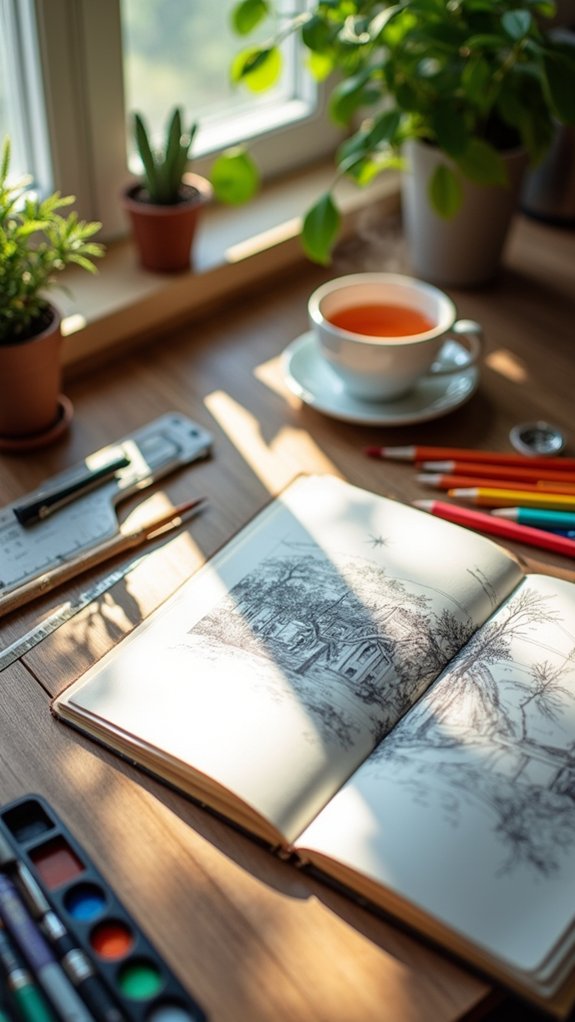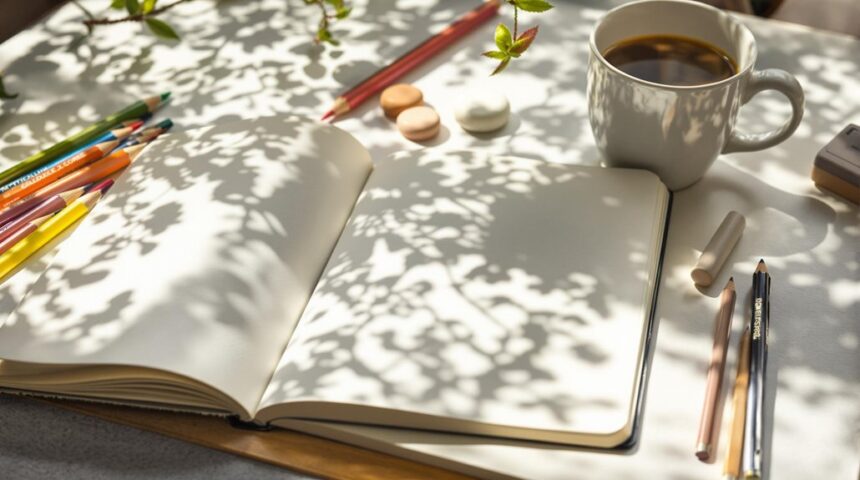Planning your sketchbook’s starting page can feel as intense as facing a boss battle, but it doesn’t have to be scary. First, decide the purpose—maybe it’s for doodles, experiments, or your “daily drama.” Pick a theme or phrase that excites you, or simply jot down the date and a funny quote. Don’t stress making it perfect; swatches, zentangles, or even skipping the first page are all fair game. Curious how to make your whole sketchbook flow just right?
Key Takeaways
- Define your sketchbook’s purpose and write a creative intention or theme on the first page to guide your practice.
- Reduce first-page pressure by starting with simple doodles, color swatches, or a favorite character—perfection isn’t required.
- Consider skipping the first page until you’re comfortable, or just date and label it to remove intimidation.
- Use the first spread for visual interest—add zentangle patterns, playful hand-lettered quotes, or personal reflections.
- Choose materials and layout in advance, lightly sketching shapes to avoid mistakes and spark inspiration from the start.
Identifying Your Sketchbook’s Purpose and Theme
Why does a blank page feel so scary sometimes?
Maybe it’s because the first page of a sketchbook can feel like a big statement—like it sets the tone for everything that comes after.
Deciding on the purpose of your sketchbook really helps beat that fear. Are you turning it into a visual diary? Maybe you’re documenting daily life, capturing what you see around you, or just doodling for fun.
Pick a theme—nature, cityscapes, even just experimenting with new techniques. Reflect on your personal artistic goals. What do you want to get better at?
Write down your creative intentions on that first page, even if it’s messy. Remember, your sketchbook isn’t locked in; its purpose and theme can grow along with you.
Overcoming First Page Pressure

Once someone figures out what kind of sketchbook they want, there’s still that one big, intimidating obstacle: the first page.
It’s like staring at a fresh, blank page, feeling as if the whole universe is waiting for some amazing piece of art. A lot of people freak out the first time—they worry about messing it up or ruining something new.
But here’s a secret: you don’t have to make the first page anything special. Some artists just skip it and start on the next one.
Others draw a favorite character or create a color swatch page to try out new pens. You could even leave the first page blank, just dating it.
These tricks honestly help take the pressure off starting a new sketchbook.
Exploring Creative Approaches for the Opening Spread
How can someone turn that scary, empty first page into something actually fun? Well, imagine entering a sketchbook filled with images, cool patterns, or bold colors—way better than just blank space!
Some artists kick things off by drawing something simple, like doodles or zentangle patterns, which instantly zap away the pressure to be perfect. Others use art materials to test out swatches of color, turning the first page into a handy reference for later.
Writing a quote in funky hand lettering sets a vibe for the whole adventure. Or, get deep by making a mind map about your new ideas or goals for starting a sketchbook.
Even jotting down the starting date and a funny reflection gives that first sketchbook page some serious personality.
Setting Up Materials and Planning Your Layout

So, with all those wild ideas for attacking the first page bouncing around, it’s time to set the scene for actual sketchbook magic. First up: pick a sketchbook with thick enough pages—no one wants surprise ink puddles on the reverse side! Gather your favorite materials, like pencils, erasers, and pens, and settle into a cozy workspace. Now for the fun part—planning your layout. Decide on a theme or central idea that gets you excited. Draft some shapes or quick doodles in pencil so you can erase any goofs. Try adding quotes or color swatches to make the page visually pop! Here’s a quick table to show what you might need and why:
| Materials/Ideas | Purpose |
|---|---|
| Pencil | Light sketches, easy fixes |
| Eraser | Oops-proofing those pages |
| Pens/Markers | Crisp layout details |
| Quotes/Swatches | Visually fun, theme starters |
Building Momentum for Consistent Sketchbook Practice
Kickstart the sketchbook journey by turning daily practice into a real-life superpower.
Building momentum isn’t just about doodling on that first page—it’s about finding your groove over time, keeping art fun, and tricking your brain into making art a habit.
Forget the pressure of making the first page perfect; you can actually fill it last, so dive right in and just start.
There’s magic in simple lines and shapes, especially when you keep a sketchbook for yourself, not for anyone else.
Here’s a plan:
- Draw something—anything—every day for 30 days.
- Set small goals like, “I’ll sketch for just ten minutes.”
- Choose a loose theme to inspire, not limit, your art.
- Plan time for sketching—like you do for snacks—so you always come back.
Frequently Asked Questions
What Should I Do on the First Page of My Sketchbook?
When considering what to do on the first page, one might use creative prompts, jot down personal goals, add inspirational quotes, test favorite materials, select a theme, explore doodle designs, or write introductory notes to guide their sketchbook journey.
How Do You Start Your First Sketchbook?
When beginning a first sketchbook, one might select sketchbook themes, jot personal reflections, add inspirational quotes, showcase favorite drawings, experiment with color palettes, define artistic goals, test sketching techniques, or design a personalized cover to inspire creativity.
How to Start a Daily Sketchbook Practice?
To start a daily sketchbook practice, one should focus on routine building, set clear goals, explore sketching techniques, seek daily inspiration, experiment with art supplies, use creative prompts, practice mindfulness, and include personal reflection to enhance progress.
How to Make the First Page of a Drawing Book?
When approaching the first page of a drawing book, one might combine creative prompts, personal goals, inspirational quotes, favorite materials, doodle ideas, artistic intentions, or themed illustrations to establish a welcoming, motivating introduction to their artistic journey.
Conclusion
Now that the first page is figured out, the sketchbook doesn’t seem so scary anymore, right? Anyone can face that blank space, armed with a plan, some wild doodles, and maybe a snack or two. With purpose, brave choices, and a good layout, getting started actually gets kind of fun! Just remember, the hardest part is opening to that first page—after that, it’s all about messing up, laughing, and letting creativity take over.


Leave a Reply